Slayer
The musical ancestors of death metal, Slayer took punk speed and simplicity and merged it with the evolving structural language of speed metal and produced angry, evil, subversive tunes which worked against the normative impulse of the society around them.
Haunting the Chapel
Metal Blade
|
1983
|
|
|
Production: Practice room muted and distorted production produces nonetheless a nice atmosphere, despite lack of clarity on guitar and ill-distinguished bass and drums.
Review: The classic opening shot for death metal, Slayer's "Haunting the Chapel," revels in Slayer's upcoming power when as a young metal band they fused primitive styles and the more flamboyant excesses of heavy metal to create primal extremity with their simple but orchestrated, artistically-significant, and socially relevant music.
The EP opens with "Chemical Warfare," a classic three-chord song paced with emotion and violence in a story of human helplessness in the face of alien manipulation and, eventually, chemical genocide. In a citation of older Black Sabbath lyrics, Slayer have Satan laughing consume the victims of this toxic holocaust, putting a mythological or perhaps even gnostic significance on top of petty human combat.
Tracklist:
1. Chemical Warfare (6:01)
2. Captor of Sin (3:30)
3. Haunting The Chapel (3:56)
4. Aggressive Perfector (3:28)
Length: 16:57
|
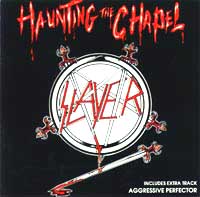
Copyright © 1983 Metal Blade
|
After that "Captor of Sin," an archetypal early Slayer song, trudges and bashes through its paces, followed by "Haunting the Chapel," a dark epic masterpiece of gloom. Through all of these songs insurgent energy, rebellious intellect, and miscreant uprising permeate as a method of living.
Finally, Slayer cap off the remastered version of this EP with "Aggressive Perfector," a Judas Priest style composition from the early eighties. Moving more slowly than their stirring live performances of this work, the recording here is probably not worth the time but the rest of the EP is excellent, high-class work which reveals the developing intellect of a groundbreaking metal band.
|
Show No Mercy
Metal Blade
|
1983
|
|
|
Production: Reasonable studio production that covers guitars and leaves a spectral but surgical drum presence in the background, nicely arching a slightly echoed voice into the mix without overamplifying the scream. Note for Remasters: Sound is actually clearer than original, at the price of digital lossiness on drums and tone (the original version is superior).
Review: Slayer originate the styles of death metal in this groundbreaking fusion of epic heavy metal with hardcore punk and nihilistic thrash bands. Tom Araya's deathbreaking scream adds color to the driving guitar rhythm hurled forward on precision chasing beats which drive with violence through a sequence of linear structures to support the protean riff structure, like most of death metal to follow holding together through the interlocked repetition of simple abstract structures.
In the conception of larger works Slayer found the complexity necessary to adapt the alienated musical elements of power chords and noise-laden speed solos into moveable pieces which fit into each codex of song, revealed here in the nascent state of artistic conceptual development and thus limited to sometimes more random pairing of component riff structures. Despite this, through ingenuity and variation Slayer build and impressive and evocative album of classic metal ideas interpreted in the freshness of conception, an artist's creative but not technical prime.
Riff architecture in rock n roll attained a new prerequisite of complexity with this release, where Slayer bond the granularity of Discharge or D.R.I. with the longer-phrased complex riffing of Judas Priest or Iron Maiden. Abstracting basic relationships of music to states of intense tension in opposition, Slayer surgically manipulate note position and strumming rhythm, creating simultaneously a style of phrase building and a technique for embedding ambient rhythm: high-speed strumming of notes or basic power chords to shape columnar structures of sustained harmonic intensity, like a tremelo in the liquid overwash spaciotemporal haze of LSD.
Tracklist:
1. Evil Has No Boundaries (3:09)
2. The Antichrist (2:49)
3. Die By The Sword (3:37)
4. Fight Till Death (3:38)
5. Metal Storm/Face the Slayer (4:53)
6. Black Magic (4:03)
7. Tormentor (3:45)
8. The Final Command (2:33)
9. Crionics (3:29)
10. Show No Mercy (3:06)
Length: 35:04
|
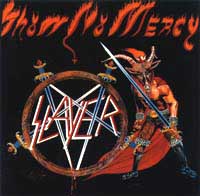
Copyright © 1983 Metal Blade
|
What amazes most about Slayer is the inherent coherence of its structure and complexity, the state of being so...naturally divergent and replicative, continuative without being contrived. Underneath the lyrics of violent death and evil subversion, the occasional rockstar vocalizations, and the relentless throb of drumming is the living warmth of an intellect asserting the power of life rather than relapsing into justification or denial. In that this music is truly "Satanic," if that word must ever be used for something so seemingly in jest, but perhaps only in the sense that for a moment artist and listener escaped their dutybound heads for a conference with the universe.
Lyrics and lead guitar alone are subjects worthy of study; in the text, Araya and lyricmates Kerry King and Jeff Hanneman issue almost metered, variable, evocative poems covering sinister conspiracies behind the roaring mutant death of a modern world. Their issue is clearly mortality and behind it, the chaotic and destructive nature of our world; as if a mirror, their lead guitar solos are broken and twisted streams of notes ellided by distortion and melodic through the resonating breakdown of microtones in each note.
Despite being often irrelevant to conventional patterns of tonal arrangement and composition, these solos have reconstructed music to speak a personalized language, one that not only works within this music but suggests a new method of interpreting music as a whole. Like the words rhythmically correspondent to a riff, or like the endless sequence of power chord riffing that reiterates a rhythm and simple vector of theme, the solos are nihilistic structures fitting into a conception distanced from anything but nihilism as a method of achieving a freedom for a chaotic, resonant, living system of metaphor to emerge unfettered into evocative fantasy.
|
Hell Awaits
Metal Blade
|
1985
|
|
|
Production: Representative of the production values of the time the soundstyling here captures the essence of guitars, drums, bass and then kicks the voice out over the top, this time with too much of a chilly overtone of echo.
Review: Fast and terrifying violent music fused from the alienated self-contrast of thrash and the accelerating rhythms of extreme speed and black metal, Slayer came hybrized but full of voice. From the clean-sung but entrenched, riot-shouted vocals of Tom Araya to the pugilistic network of respondent drumbeats upholding a harangue of ambient fast-strummed riffs and nervous, erratic, chaotic metaspoken lead guitar.
Noise-based as much of the guitar pyrocuneiform is, the power of Slayer's composition is to amplify a simple virus through breakdown into multiple variations of a core rhythm in architectural riffs built from fragmented scales and basic harmonic ideas to emphasize basic mathematical concepts behind the doomscience of lyrics and budding death metal aesthetic. Even the faster speed songs and the savage self-combative moments of thrash carry a complexity borrowed from the progressive rock gods of the previous generation and the metal masters who bestowed their creations with the complex metaphorical language of imagination.
Tracklist:
1. Hell Awaits (6:15)
2. Kill Again (4:56)
3. At Dawn They Sleep (6:17)
4. Praise of Death (5:20)
5. Necrophiliac (3:46)
6. Crypts of Eternity (6:38)
7. Hardening of the Arteries (4:00)
Length: 37:14
|
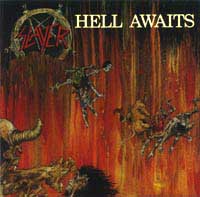
Copyright © 1985 Metal Blade
|
Rhythmic emphasis comes entirely through guitars, which lead drums because the linear complexity tracking of the song moves fluidly through the variations of riffing which move, ambient, through patterns over the percussive components of the song, allowing drums to maintain greater simplicity and to unleash guitars to freedom of voicing over predictable rhythm upholding self-defined major components of each song. Slayer's composition is often called chromatic, meaning that it uses linear scales, but more appropriately it is nihilistic: a note or chord becomes the basis for invention of new recombinant pieces of information, creating a self-specialized evolutionary compositional space for the conception of each song.
Nihilism pervades also the virulent lyrics and the haphazard, almost careless method with which guitarists K. King and J. Hanneman drop into a solo and work it through some motions of noise. The core of this comes within the text of Slayer's obssession with the seat of control of violence and death, as well as from the alienated methodology of their major ancestors in hardcore and thrash. However nihilism is not their excuse, only their origin; without pretense they wrest beauty from the essential deconstruction of music, and from that beauty they create romantic epics of despair and oblivion that influenced all metal, and much of popular music, to follow.
|
South of Heaven
Def Jam
|
1988
|
|
|
Production: Slim and full, not sterile yet clean.
Review: The most darkly imposing of the Slayer albums, "South of Heaven" achieves a demonic sound through a breakdown of music to pure patterning, in which harmony serves a dark spirit rising only occasionally from the ripping chromatic riffs and chaotic solos that surge from one end of the spectrum to the other conducted by ingenious reinvention of inertia. The musical style lingers toward the more abstract end of the speed metal and death metal movements, with fast riffing that presages the work of Morbid Angel or Massacra balanced by intricate lead riffing in which grand visual aspects to a rhythmic sequence of notes are established.
Tracklist:
1. South of Heaven
2. Silent Scream
3. Live Undead
4. Behind the Crooked Cross
5. Mandatory Sucide
6. Ghosts of War
7. Read Between the Lines
8. Cleanse the Soul
9. Dissident Aggressor
10. Spill the Blood
Length: 36:57
|
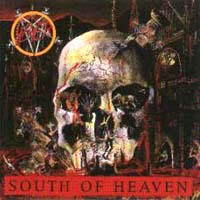
Copyright © 1988 American
|
Nearly mystical in its hypnotic surging of rhythm and disturbingly abrupt shaping of sound, this album gains its technicality from the adept rhythmic changes and precision it employs, fashioning its own earful from power chords and forthright fretboard patterns under muffled strum. Tom Araya's spread vocals drape over the percussive foundations of each phrase, expanding as the rapid but detailed in texture drumming of Dave Lombardo accompanies movement in tone and impact. Dual rhythm/lead guitarists not only sketch individual portions of the riffscape but provide a spatial depth to the use of tone in soloing. The end result is straightforward, extreme metal with a distant hardcore background that is used to construct truly placeless and centerless riffs, in which motion becomes the creator of pattern and pattern defines tonal shape and thus any harmonic characteristics the song will have as arrayed in narrative, making an undeniable rhythm move with a careful and compact integration of drum patterns and guitar motion. A cover of Judas Priest's "Dissident Aggressor" fits in revealingly well among these basic sonic motions in complicated arrangements with an unyielding energy only tamed, not muted.
Slayer were an important connective tissue of metal, bringing together the most disturbed neo-prog NWOBHM concepts and the most extreme minimalist conceptions of music from hardcore and crossover, creating an aesthetic foundation upon which other artists built, most notably in the death metal movement, producing a palette of techniques added to the voices of popular music. Slayer's influence can be found in the choice of classical music presented to young people, the riffs of over 100,000 metal bands, and the pirate radio stations in countries under collapsing democracy. This album shows a clear lexicon of Slayer styles, but like the later albums from formative heavy metal bands, attempts to pattern in deliberate musical action what in youth had become too emotively uncontrolled music. Dreaded maturity? That and raging spirit toward making songs of Hell.
|
Seasons in the Abyss
American
|
1991
|
|
|
Production: Turgid and strong, surface-level treatment.
Review: Falling into a midlife crisis, a somewhat reluctant Slayer returns with an album that is powerful in its emotive instinct but unfocused in its construction and theme, producing an ambivalence and a sometimes forced aggression mixed in its urgency. Songs eschew some of the subtlety of previous releases, preferring to whip out the powerful riffing right away and use like grindcore bands longer even phrases of whole intervals and longer chromatic extensions to rhythm riffs.
The bulk of the music as in previous Slayer albums is the adept riffing of Hanneman and King interlaced with the spacious but precise drumming of Dave Lombardo holding a quick perceptual framework over the changing narrative of the music. Tom Araya attacks his vocals with a more consistent aggression and attempts melodic radio sleekness during the start of the second side, but this is restrained by a seemingly iconographic imperative of rushing speed and E power chord chomping on the downstroke. The bottom line is an onslaught of sonic distortion that is capped and highlighted by its chaotic solos, twisting through a wasteland of abrupt two-string chord barrage and a rippling roar of unleashed tremolo strumming. This hummingbird wingbeat technique allows Slayer to achieve a simple harmonizing effect as Discharge did in 1982, making a searing connection between notes that emphasizes their melody without detracting from rhythm and power riffing.
Tracklist:
1. War Ensemble
2. Blood Red
3. Spirit In Black
4. Expendable Youth
5. Dead Skin Mask
6. Hallowed Point
7. Skeletons Of Society
8. Temptation
9. Born Of Fire
10. Seasons In The Abyss
Length: 42:31
|
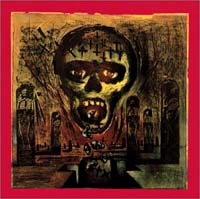
Copyright © 1991 American
|
While this album carries all the basic elements of the Slayer formula, it loses some of the momentum and wisdom behind previous choices, creating an album that was not fully ready and not really where the band wanted to take their music, but still a strong contender in the way the late middle albums of Iron Maiden remained solid despite some disorganization. This was the last of the Slayer albums to contain any strength of will or spirit, so it is romanticized by many, yet seems in some ways a removal from the intensity of previous Slayer attempts which so profoundly influenced death metal as an emerging genre.
|
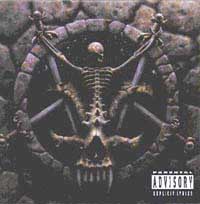
1. Killing Fields (3:57)
2. Sex, Murder, Art (1:51)
3. Fictional Reality (3:37)
4. Dittohead (2:31)
5. Divine Intervention (5:34)
6. Circle of Beliefs (4:29)
7. SS-3 (4:07)
8. Serenity in Murder (2:36)
9. 213 (4:52)
10. Mind Control (3:05)
Length: 36:41
|
Divine Intervention (American Recordings 1995)
The tight speed metal structuring of Seasons in the Abyss has given way to uninspired, predictable phrasing and more singable, chantable, rememberable songs illustrating the adage: if content is beyond you, make something slick and it'll last for 15 minutes of fame. Previously Slayer's architectural riffs contrasted each other so strikingly as to be impossible not to notice the find songs and concepts unique, but here a series of discontiguous riffs make up an album which is roughly tied together by a ranting scream generating some pretty unimpressively bland (and often stupid) lyrics. Tom Araya's singing voice strains overdriven into a low mike yet his groining singing is the prominent part of the mix. Under it guitars lurk at three chords, with a lot of emphasis on rhythmic strumming to syncopate with Araya's cadence of mostly repetition. The result: a complete lack of metaconcepts, a complete lack of vision, a complete lack of artistic impetus. Many directions pull the will behind this album apart: Pantera's success, Metallica's success, the rising Metalcore genre, a desire to avoid Seasons the second, and a lust to fulfill the need for what they see as the issue, which is the public wanting another Reign in Blood -- a need they interpret to be a yearning for "simple, fast" as opposed to the magnificent structure and potency of sublime rage that was that foundational album.
|
BLACK | DEATH | HEAVY | SPEED | THRASH | GRINDCORE
Copyright © 1988-2004 the Dark Legions Archive
|





